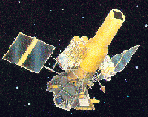|
|
The Granat Satellite

GRANAT was a Russian dedicated X-ray/gamma ray
astronomy mission in collaboration with other European countries.
Launched on 1 December
1989, Granat operated for almost 9 years.
After an initial
period of pointed observations, Granat went into survey mode in September
1994.
Mission Characteristics
 Lifetime :
December 1, 1989 - November 27, 1998 Lifetime :
December 1, 1989 - November 27, 1998
 Energy Range :
2 keV - 100 MeV Energy Range :
2 keV - 100 MeV
 Payload : Payload :
- Coded-mask X-ray telescope (SIGMA)
0.03-1.3 MeV, eff. area 800 cm2, FOV 5°x5°
- Coded-mask X-ray telescope (ART-P)
4-60 keV, eff. area 1250 cm2, FOV 1.8°x1.8°
- X-ray proportional counter spectrometer (ART-S)
3-100 keV, eff. area 2400 cm2 at 10 keV, FOV 2°x2°
- All-sky monitor (WATCH)
6-120 keV, eff. area 45 cm2, FOV All-sky
- Gamma-ray burst experiment (PHEBUS)
0.1-100 MeV, 6 units of 100 cm2 each, FOV All-sky
- Gamma-ray burst experiment (KONUS-B)
0.02-8 MeV, 7 units of 315 cm2 each, FOV All-sky
- Gamma-ray burst experiment (TOURNESOL)
0.002-20 MeV), FOV 5°x5°
 Science Highlights:
Science Highlights:
- A very deep (more than 5 million sec.) imaging of the galactic center
region.
- Discovery of electron-positron annihilation lines from the Galactic
"micro-quasar" 1E1740-294 and the X-ray Nova Muscae.
- Study of spectra and time variability of black hole candidates.
 Archive :
HEASARC hosts the PHEBUS Gamma-Ray Burst Catalog
Archive :
HEASARC hosts the PHEBUS Gamma-Ray Burst Catalog
[Granat Home]
[About Granat]
[Archive]
[Gallery]
[Publications]
[All Missions]
[by Time]
[by Energy]
Page authors: Lorella Angelini Jesse Allen
HEASARC Home |
Observatories |
Archive |
Calibration |
Software |
Tools |
Students/Teachers/Public
Last modified: Thursday, 24-Sep-2020 19:26:06 EDT
|


